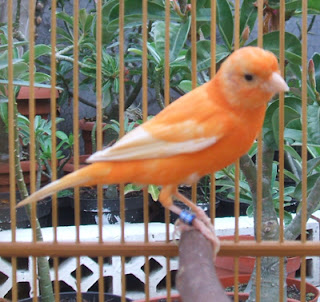 The male has a beige front with half of the crown of a red rose, the color can be replaced by the yellow-brown. The beak is yellow with the upper mandible flamed. The trais eyebrow, grayish beige, are close and regular, starting above the eyes and going up the neck. The eyes are black. Cheeks and ear region have a drawing of a half moon shape and are of a gray-brown tinged with pink. The Lorum are gray.
The male has a beige front with half of the crown of a red rose, the color can be replaced by the yellow-brown. The beak is yellow with the upper mandible flamed. The trais eyebrow, grayish beige, are close and regular, starting above the eyes and going up the neck. The eyes are black. Cheeks and ear region have a drawing of a half moon shape and are of a gray-brown tinged with pink. The Lorum are gray. Neck, back and shoulders are light gray with dark gray streaks regular. The color of the throat is pale gray with small dark gray skirt the size of a pea. The background color of the chest is gray with gray streaks on the upper chest, in adult males the breast may be pink. The background color is light gray sides regularly streaked with gray, from the top of the chest and down the flanks. The belly is dirty white. In the wings, big plans are of a dark gray, edged with gray at the tips of feathers. The two wing bars are a light gray. Rump is pale gray streaked with dark gray. At the tail, the tail feathers are dark gray, edged with gray at the tips of them. The legs are of a greyish color with black nails. The female, meanwhile, carries the same livery as the male, but it never rose on the chest, but only on the crown.
 14.41
14.41
 bird
bird



















